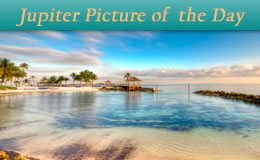The very first Europeans to visit the area of Jupiter Florida were the Spanish Conquistadors in the mid 1600s. They were searching for gold and found the beautiful tropical setting that is now home to Jupiter Florida.
History of Jupiter Florida
Before the Conquistadors came searching for gold the area was inhabited by a tribe of Native Americans called the Jeaga and Jobes. The Spanish visitors mistakenly pronounce the name Jobes as “Hoe-Bay” which in turn gave the name of Hobe Sound to that area. The remains of these early Native American tribes can be found through out the local Jupiter museums.
A shipwreck in 1696 led to the arrival of Jonathan Dickenson where he was beached on Hobe Sound Beach. He was on a voyage from Jamaica to Philadelphia when he was caught in a hurricane. Some of the local area landmarks are name in his honor.
In the 1800s the Seminole Indians controlled the area. Some of their language can be seen in the local area naming. The Seminole word for turtle is “lowchow” and the word “hatches” is river and the were combined to name the Loxahatchee River and the area around it.
In 1838 on the Loxahatchee River the bloody Seminole Indian War was fought and ended. After the Seminole Indian War was fought over 9000 acres created the Fort Jupiter Reservation. During the time of the Fort Jupiter Reservation the most famous South Florida and Jupiter landmark was created. It was the 100 plus foot Jupiter Lighthouse which is still standing and a very popular tourist destination. The Jupiter lighthouse still exists and operates. It warns incoming shipJupiter Florida Lighthouses of the hazardous coastal shoals.
During the Civil war the lighthouse was a key point in helping the Union Army spot Confederate blockade runners trying get supplies to the Confederate Army. In 1861 the lighthouse was darkened by Confederate sympathizers who hid the light so Union ships could not spot the blockade runners. The light was restored in 1866 by James Armour and since then the light has only been darkened twice. Once for only 2 hours by a drunk assistant who forgot to light it. And then in 1928 a hurricane batter the coastline of Jupiter and knocked out all electrical. Charles Seabrook re lite the Lighthouse during the storm that was recorded as one of the worst that ever hit South Florid.
The Jupiter area was renown for being the transportation center of southeastern Florida. It’s rivers were traversed by scows, sailboats and steamboats and it was also known for its floating hotels. Grover Cleveland and the first lady fished from one of these floating hotels that was docked at the Jupiter Lighthouse.
In 1890 the population of Jupiter was estimated at around 850. By the year 1910 it had swelled to over 17,000 and today it maintains a population of over 50,000.

 Powered by:
Powered by: